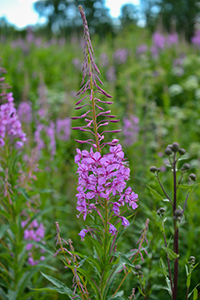Table of Contents
The rosebay willowherb is a beautiful plant of the European mountains. Its beautiful colors make us joyful, and it sweetens all herbal teas. It is highly appreciated in Northern Europe, and its young buds are often consumed in salad dishes.
- 100% Natural product without any additives
- The highest quality – Herba Organica
- The best selection of herbs hand-packed
- Collected from the wild state
Rosebay Willowherb Scientific Facts
- Scientific Name – Epilobium Angustifolium L.
- Other Names – Rosebay, willowherb.
- French – Épilobe.
- Spanish – Epilobio.
- Environment – Widespread all over Europe and northern Asia. It grows in cold mountain forests.
- Description—This vibrant plant of the Asteraceae family grows from 70 to 100 cm high. Its bright pink or purple flowers have four petals and four sepals.
- Parts of the plant used medicinally – Dried flowers, leaves, and roots.
Healing Properties

The entire plant contains tannins, pectin, and mucilage. It has astringent properties due to its content of tannin and emollient properties (reduces the inflammation of the skin and the mucosa) due to its content of mucilage and pectin. Its most common applications are the following:
- Diarrhea, gastroenteritis, and, as a rule, all inflammations of the digestive mucosa. Besides its astringent properties, rosebay willowherb also has anti-inflammatory properties. It stops diarrhea and eliminates abdominal discomfort.
- Stomatitis (inflammation of the oral mucosa), gingivitis, and pharyngitis: when applied in mouth rinses and gargles, it has anti-inflammatory properties and produces a pleasantly cool sensation in the mouth.
Other Rosebay Willowherb Species

In the genus Epilobium, there are other species whose common names are frequently exchanged, such as Epilobium hirsutum L. or Epilobium alsinfolium L. There are some 20 species of rosebay willowherb, all of them with very similar medicinal properties.
How to use Rosebay Willowherb
- Infusion with 50 grams of the dry root, flowers, and leaves. Fresh flowers should be avoided. Drink four to five cups daily.
- Mouth rinsings and gargles. With the infusion mentioned above.
Frequently Asked Question
I’ve heard rosebay willowherb is good for prostate health. How does this work?
Research, while not yet extensive in humans, suggests potential. Lab and animal studies show compounds in rosebay willowherb have anti-inflammatory and antioxidant effects, which could play a role in managing prostate issues like benign prostatic hyperplasia (BPH).
Can rosebay willowherb support my immune system?
There’s promising evidence. It’s rich in vitamin C, and studies show it has potential immune-boosting properties. In the lab, the plant can increase immune cell activity.
Does rosebay willowherb have actual anti-cancer potential?
Initial research is intriguing, but it’s very early to say definitively. Studies on cell cultures suggest specific plant extracts may have antiproliferative and antioxidant effects that might be useful in cancer prevention or alongside traditional treatment.
How effective is rosebay willowherb for digestive issues?
Traditional use supports this benefit. Its soothing mucilage and astringent tannins help calm inflammation and diarrhea. Some studies suggest its antimicrobial properties may even help balance gut flora.
I’ve been dealing with frequent coughs and sore throats. Can it help?
Potentially. rosebay willowherb’s demulcent (soothing) and anti-inflammatory properties have been traditionally used for these issues. A tea made from its leaves might offer relief.
Are there any potential side effects of using rosebay willowherb?
It’s generally considered safe for most people, but if you have existing health conditions or are on medication, always consult your doctor first. Some people may have minor stomach problems or changes in how often they use the bathroom.
Can I consume rosebay willowherb during pregnancy or breastfeeding?
There isn’t enough safety data on its use in pregnancy and breastfeeding. It’s best to err on the side of caution and consult a healthcare practitioner before using it.
What are the best ways to use rosebay willowherb for these health benefits?
Tea from the leaves and flowers is typical. Extracts, capsules, and topical salves are also available. Dosage recommendations can vary, so check with a qualified herbalist or your doctor.
Are there drug interactions I should be aware of?
Research is limited, but there’s a theoretical possibility of interactions with blood thinners or medications affecting blood pressure. Again, talking to your doctor is vital.
Where can I find reliable information about rosebay willowherb?
Reputable herbal medicine societies, scientific databases like PubMed (https://pubmed.ncbi.nlm.nih.gov/), and publications by qualified herbalists offer trustworthy information.
- 100% Natural
- Ground Raw Wild Harvested, No GMO, Vegan
- Ingredients: fermented large-leaved rosebay willowherb (Ivan Tea), fir needles, spruce needles, origanium (herb), dried tangerine, sea buckthorn berries.
DISCLAIMER: All content on this website is presented solely for educational and informational objectives. Do not rely on the information provided as a replacement for advice, diagnosis, or treatment from a qualified medical expert. If you are pregnant, nursing, or have any preexisting medical concerns, talk to your doctor before using any herbal or natural medicines.
REFERENCES
- George D. Pamplona-Roger, M.D. “Encyclopedia of Medicinal Plants.” George D. Pamplona-Roger, M.D. Encyclopedia of Medicinal Plants. Ed. Francesc X. Gelabert. vols. 2 San Fernando de Henares: Editorial Safeliz, 2000. 501. Print.
- https://www.ncbi.nlm.nih.gov/pmc/articles/PMC5090966/
- https://www.eatweeds.co.uk/rosebay-willowherb-epilobium-angustifolium
- https://edwinahodkinsonherbalist.co.uk/f/of-moorlands-and-mill-towns—the-medicine-of-rosebay-willowherb
- https://www.theforagingfoodie.co.uk/plants/rosebay-willowherb/
Last update on 2024-07-25 / Affiliate links / Images from Amazon Product Advertising API



